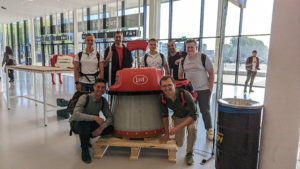Archive for July, 2022
The IGMR visits the Automatica in Munich

After a long, involuntary break, IGMR was able to visit Automatica in Munich for the first time again. Together Jan Wiartalla, Amir Shahidi and Sophie Charlotte Keunecke explored various innovations and presentations and had many interesting conversations. In addition, some final year students of RWTH and IGMR presented their extremely interesting projects at Automatica and offered an exclusive view even beyond the exhibited possibilities.
On the last day of the fair, June 24. 2022, Sophie Charlotte Keunecke represented IGMR at a panel discussion on “Automation and robotics: what drives the new generation?” at the Automatica Forum. You can find the video here on the Youtube channel of Automatica.
Contacts:
Sophie Charlotte Keunecke
Jan Wiartalla
Haptic Feedback System RePlaLink
The videos are also available on our Youtube channel:
Humans interact with hand-actuated products on a daily basis. Examples are car doors, manual presses, furniture doors, machine housings, fitness equipment, or reconfigurable types of furniture. The RePlaLink can be used for the simulation and haptic representation of such mechanisms based on virtual prototypes. This makes it possible to improve the development process of such systems and reduce the use of physical prototypes.
The RePlaLink consists of a servo-driven kinematic structure with a handle as haptic interface. Due to its structure, it is particularly well suited to simulate planar mechanisms. The system measures, among others, the user forces, takes them into account in a real-time simulation of the virtual mechanism and displays its reaction. This allows users to directly feel the mechanism’s haptic properties while operating the system. Users can change them interactively by modifying the mechanism’s parameters and get direct haptic feedback. This enables fast, inexpensive, and frequent validation and evaluation of haptic properties, even at early development stages. The videos introduce the structure of the RePlaLink and show the haptic simulation and synthesis of an exemplary hand-actuated mechanism.
You can find more information about the project here.
Contact person:
Jan-Lukas Archut
Mahshid Pour Ebrahimabadi
Results of the project Next Generation
Der an dieser Stelle eingebundene Inhalt führt Sie auf Seiten, die von der von Google betriebenen Seite YouTube - YouTube, LLC, 901 Cherry Ave., San Bruno, CA 94066, USA - zur Verfügung gestellt werden. Mit dem Aufruf des Inhalts kann YouTube Ihre IP-Adresse und die Sprache des Systems, sowie verschiedene browserspezifische Angaben ermitteln. Wenn Sie in Ihrem YouTube-Account eingeloggt sind, ermöglichen Sie YouTube, Ihr Surfverhalten direkt Ihrem persönlichen Profil zuzuordnen. Dies können Sie verhindern, indem Sie sich aus Ihrem YouTube-Account ausloggen. YouTube verwendet Cookies und Tracking-Tools. Die Datenverarbeitungsvorgänge sowie die Zwecke der Verarbeitung können direkt bei YouTube erfragt und eingesehen werden.
At the end of the Next Generation project, the perspectives of all those involved were collected. As always, the focus is on people. With the inclusive workplace and the collaborative robot, the project shows new perspectives for the employment of people with multiple disabilities. HRC is an enabler for inclusion in the primary labor market! We are happy about the great project results and the video reflecting them.
For more information about the project, click here.
Contacts:
Carlo Weidemann
Elodie Hüsing
Mathias Hüsing
Participation at European Robotics Forum (ERF) Hackathon 2022

As part of the European Robotics Forum (ERF) Hackathon 2022, six IGMR students demonstrated their talent in prototyping and working with robots. The hackathon challenge was set by Lely, among others. Their ‘Juno‘ mobile robots are autonomous cylindrical platforms whose main task is to move the fencing around cows on farms to make the feed pushed into the space accessible again. The hackathon task was similar: two Juno robots had to move along the walls of two interconnected rooms at a given distance. Additional restrictions and challenges were added for extra points. The team was successful at the hackathon in Rotterdam. After a neck-and-neck race, the first place went to TU Delft. At the award ceremony, we were praised as the most cooperative team for our “constant support of other teams in design and 3D printing“. This ‘exemplary behaviour‘ is much appreciated and we look forward to taking part again next year.
Special praise goes to our students Sebastian Polzin, Frederik van Kerkom, Jonas Braun, Oleksander Kutovyi, Ali Berger and Yannik Freischlad for their efforts. We congratulate TU Delft on their well-deserved victory and are happy to have won many new friends and valuable contacts. We thank the institute management for the opportunity to participate and look forward to next year.
Contact:



